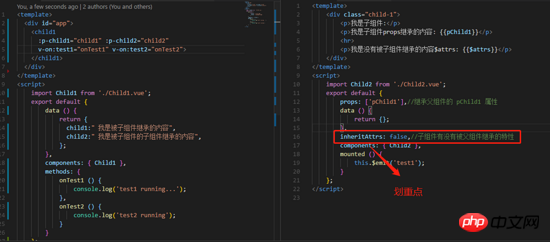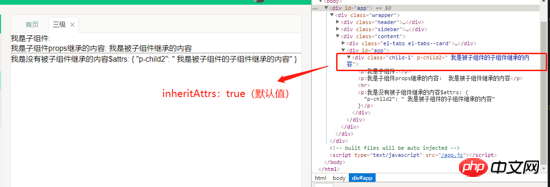
This time I will show you how to implement data transfer between Vue parent and child components, and what are the precautions for implementing data transfer between Vue parent and child components. The following is a practical case, let's take a look.
When we are writingvue components, we may use data transfer; to pass the data of the parent component to the child component, sometimes we also need to pass it through the child component Event to trigger the event of the parent component;
props Method of passing to child components (parent-child components)
vuex Perform state management (parent-child components and non-parent-child components) vuex
Vue Event Bus uses Vue instances to implement event monitoring and publishing, and to achieve transfer between components.
inheritAttrs $attrs $listeners
attrs and listeners AttributesUsed and Vue.js best practices (five tips to help you Become a Vue.js master)
vuex is suitable Used in large projects. I have used the third method in my graduation design, but I don’t seem to have seen it elsewhere. At that time, there was only one function that needed to transfer data between sibling components. Using vuex is overkill. , and also requires time cost. So I chose Vue Event Bus; for the last method, I have not seen it applied in projects yet. But I personally feel that since there is this api, there must be a reason for its existence. Otherwise, what's the point of its existence? ? If there is a need, I personally think you can try it; embrace change and embrace opportunities
bug, sometimes the conventional method is not necessarily the best. It may be better to think outside the box and solve problems in an outside-the-box way. Conventional methods can solve the problem but are somewhat bloated. It is more interesting to experience it in the actual mining pit
inheritAttrs $attrs $listeners
inheritAttrs: The default is true
inheritAttrs :false


inheritAttrs :false

 ##c='ture1.png'>
##c='ture1.png'>
Official explanation: By default, the parent role Domain attribute bindings (
attribute bindings ) that are not recognized as props will "fall back" and be applied to child components as normal HTML attributes on the root element. When writing a component that wraps a target element or another component, this may not always conform to the expected behavior. By setting inheritAttrs to false, these default behaviors will be removed. These attributes can be made effective through the instance attribute $attrs (also new in 2.4), and can be explicitly bound to non-root elements through v-bind.
My explanation is: store data that is not inherited by subcomponents
Official document explanation: Contains attribute bindings (except class and style) that are not recognized (and obtained) as props in the parent scope. When a component does not declare any props, all parent scope bindings (except class and style) will be included here, and internal components can be passed in via v-bind="$attrs" - when creating high-level components very useful.
$listeners
My understanding is: child components can trigger events of parent components (no need to use those troublesome vuex or an empty Vue Instance as event bus, or something else vm.$on )

Official document explanation: Contains the ( in the parent scope (without .native decorator) v-on event listener. It can be passed into internal components via v-on="$listeners" - very useful when creating higher level components.
I believe you have mastered the method after reading the case in this article. For more exciting information, please pay attention to other related articles on the php Chinese website!
Recommended reading:
How to use JS to implement the Baidu search box
How to internationalize your js code
The above is the detailed content of How to implement Vue parent-child component data transfer. For more information, please follow other related articles on the PHP Chinese website!
 Vue parent component calls the method of child component
Vue parent component calls the method of child component
 How to bind data in dropdownlist
How to bind data in dropdownlist
 Introduction to laravel components
Introduction to laravel components
 How to register on Binance
How to register on Binance
 Delete search history
Delete search history
 How to download nvidia control panel
How to download nvidia control panel
 What are the differences between springcloud and dubbo
What are the differences between springcloud and dubbo
 The role of linux operating system
The role of linux operating system




